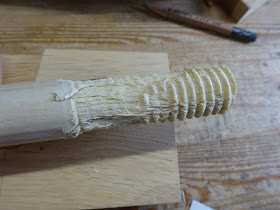Having finally had success making a 1 1/4" wooden screw, I wanted to try one like the item that originally started me down the wooden screw rabbit hole.
Around 2015, I bought an old Ohio Tool screw-arm plough plane. Among many other things that needed fixing were the wooden screws, whose threads were not in great shape.
 |
| Before repair, showing damaged threads |
The threads close to the fence were completely toast, and I eventually cut out the bad portion (about 1") and doweled the screws back together. But it had me wondering what it would take to replace the screw arms. The original screws have (approx.) 13/16' major diameter, 11/16" minor diameter, and 7 1/2 threads per inch. The angle between peaks is 60°.
At that time I made a screw-box that didn't work and I had made a screw from maple using a saw and files.
 |
| The maple screw with chipped threads. It's ugly, but it could thread onto the plough plane's nut. The paper template at right was used to guide the saw cut. |
So having had some recent success making a larger screw using a homemade screw-box, I thought I'd try making a screw like the one on the plough plane. First comes the nut and these have been relatively easy to make.
 |
| Here's the kerfed 11/16" rod with cutter for cutting inside threads |
 |
| The cutter is in a cylindrical hole and is wedged front and back with a 1/4" dowel sawn in half. The cutter was made from a piece of an old saw blade. |
 |
| The metal guide that the kerf of the tap runs on is an old hack saw blade with a curved notch filed into it. Its thickness fit the kerf very nicely. |
I made a few test nuts before cutting inside threads on the piece that will be the main block of the thread-box. They came out pretty good and fit on the plough plane screws nicely. On some I used mineral oil or BLO to lubricate / soften the wood to be threaded.
 |
| A nut in poplar - threads a little fuzzy |
 |
| Nuts in poplar (near) and soft maple shown threaded onto the original plough plane screws |
Here's the rub with the nuts. Since inside threads are cut into the rear block of a thread box, the threads should be fairly clean so that when making a screw, the newly cut outside threads can mesh well with the inside threads. On poplar, my threads were quite furry. I had used some mineral oil and later BLO to soften the wood before threading it, and this left threads that were not so clean.
 |
| A little fuzzy and this is along the grain |
 |
| Closer to cross-grain, the threads are very fuzzy |
I did a little experiment, cutting inside threads in a mystery hardwood. On one piece, I used BLO to soften the wood before cutting, the second piece was dry.
 |
| With BLO: fuzzy threads |
 |
| Without BLO: fuzzy threads, especially at the cross-grain areas. I skipped the oil for subsequent nuts. |
I used a piece of the mystery hardwood for the main block of a screw-box. I took the cutter I had made a few years ago, reshaped it, and sharpened it much better.
 |
| The screw-box I made a few years ago, that I never got to work properly |
 |
| Here it is next to the one I made last week that worked right. Note the difference in the shapes of the cutters. |
After I fit the cutter to a new screw-box, I tried running a 13/16" screw blank through it and actually got some threads!
 |
| Freshly cut threads in poplar coming out the back of the screw box |
 |
| More threads (at the right pitch), but ... |
 |
| ... then they started to get all munged up |
I think chips were getting caught inside the box. Also, the inside threads in the screw-box got damaged. Poplar probably wasn't a good choice for threading a 13/16" diameter rod and the mystery hardwood probably wasn't ideal for the screw-box.
This is getting long, so I'll stop here and resume in the next post.
No comments:
Post a Comment